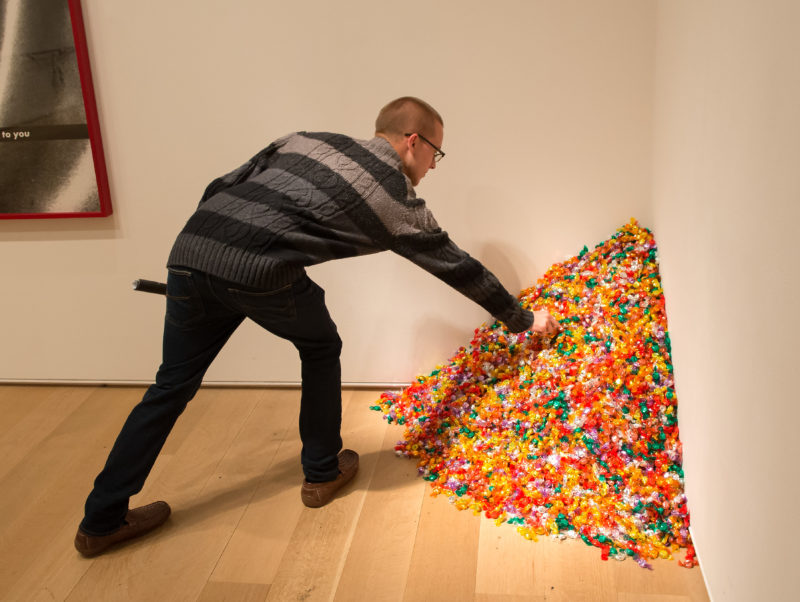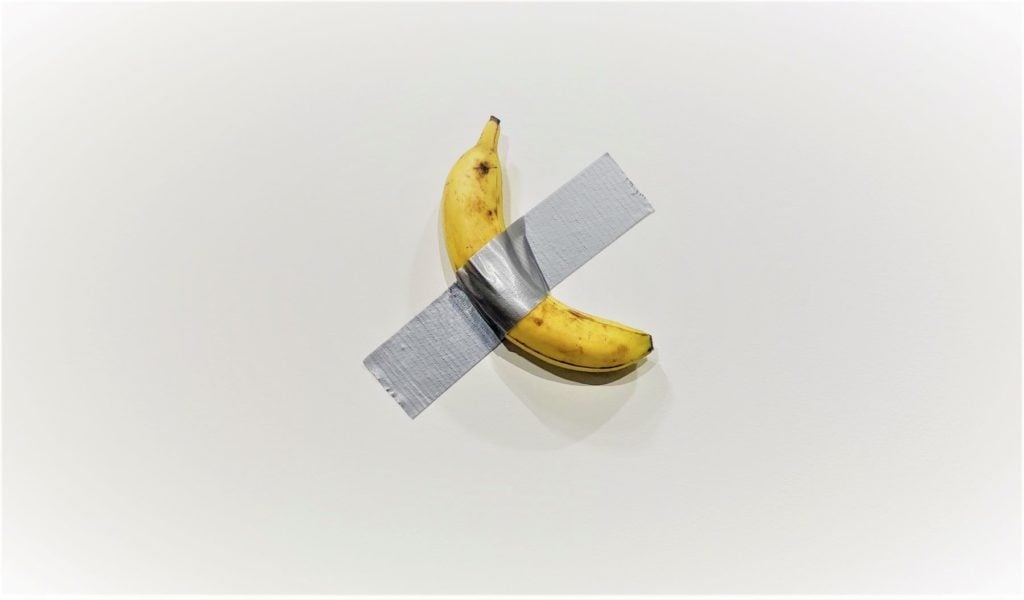The Rise of Storytelling Through Post-Modern Conceptual Art
Conceptual art is not for everyone. Many people will go to a conceptual art exhibit and simply say, "Well I could've done that, I don't know what the big deal is." People who are fans of the art form will usually respond with, "Well you didn't so..." But to me, the response should be a bit deeper than that. While I don't believe that everyone HAS to like conceptual art, I think it's important to understand where the art is coming from and what it's trying to say. Just because something is not a beautiful, detailed, conventionally easy to understand painting doesn't mean that it can't tell a story.
The Dada movement, though short-lived, was a sort of catalyst for conceptual art. Most can directly attribute a huge shift in the art world to Duchamp's 1917 Fountain. Before that, no one had really taken a ready-made object and tried to make it mean something else. The piece stood out to question what exactly makes something art?

Untitled (1991) is a work by Felix Gonzalez-Torres (1957-1996). A permanent display resides in Los Angeles. Some installations of this work carry different representations but the one featured in the photo above is Untitled: A Portrait of Ross. Gonzalez-Torres was a gay man living in the times of the AIDs panic. His boyfriend, Ross, had died from the disease in 1991. In A Portrait of Ross, roughly 175 lbs of candy are placed in the corner of a room and guests are encouraged to take a piece as they see fit. Ross was about 175 lbs and the candy is meant to represent the weight that was depleting from his body as he was dying. There is also a representation of the sweetness of a loved one running out as they begin to die.

Don’t be afraid of the clocks, they are our time, the time has been so generous to us. We imprinted time with the sweet taste of victory. We conquered fate by meeting at a certain TIME in a certain space. We are a product of the time, therefore we give back credit where it is due: time. We are synchronized, now forever. I love you.
Tracy Emin is a conceptual artist who became well known for telling personal information about herself through her art pieces.

My Bed (1998, London) was very controversial at the time of it's display and probably still is today. It features an unmade bed, as well as some personal items scattered around: cigarette boxes, used condoms, empty liquor bottles, a razor, etc. It was modeled after Emin had just had a very rough week and spent a great deal of time depressed in bed. When she finally emerged and saw the state of it, she saw art. There's a sort of beauty in the raw emotion and honesty that the piece shows. It's seen as very "unladylike" so it sparks a conversation on what femininity is viewed as in society.

Emin is featured here with her portrait This is Life Without You (2018, England). Self-explanatory with the title, it's an exploration of loneliness and grief. The painting is messy and the figure is blob-like and uncomfortable. Paintings like this appear simple and I'm sure have the "Well I could've done that," commenters buzzing. However, this would be quite a hard painting to recreate on a whim. The background is a very pale beige with no visible brushstrokes while the aura surrounding the body is a white with scattered pink shadows. On top of that, the messy, non-conforming body is drawn and the shades of red dripping from it differ. It oozes an emotion that maybe only those who have experienced will be able to feel looking at this painting.

This is a piece by the Mexican artist Teresa Margolles titled Narcomensajes (2009, Mexico). Displays of this piece are often replicas as the original work was done by Margolles taking a white flag and draping it over bodies, absorbing their blood. The bodies were victims of crimes relating to drug wars in Mexico. Margolles often explores the consequences of death and murder on society through her work. Seeing fabrics that were once completely white change into the reddish brown of dried blood conjures an image of the amount of violence taking place. It's a perfect example of how conceptual art can merge into politics.
Finally, I'd like to mention a piece that I'm sure everyone has heard about.

Comedian (2019, Miami) is a banana duct-taped to a wall done by Italian artist Maurizio Cattelan. It recently sold for $6.2 million dollars at an auction in November 2024. There is some technicality to the banana; it can't be upside down, there are measurements to ensure the correct angle of the duct tape, etc. Many articles and new stories cover this piece, so I'd like to simply put in my own input. I think the joke IS the amount of money that this work has sold for. In 2019, it was sold for $120,000 US dollars and the man who bought it, took it off the wall and ate it. It also had to be removed from exhibit as it was drawing dangerous levels of crowds. Huge influxes of people were coming to see and take a picture of this banana to post on social media. Maybe the art here isn't the banana taped to a wall but the comical response of the public to it. A dystopian aura surrounds the impact that Comedian has had on the world. Do people flock to it because it sold for a lot of money? Did the money make the banana special in some way? It couldn't have because the buyer just ate it like normal, right? Why would anyone with that kind of money spend it on that? Is it important because the artist said so or because someone somewhere said so? It draws out so many questions people have about society. So, instead of just being annoyed that a banana duct-taped to a wall is considered art, ask some questions about the bigger picture surrounding this phenomena.
To wrap up my thoughts, it's easy to complain about how art used to be amazing works like the Sistine Chapel and how what is considered art today is so simple. I'm not saying anyone needs to like conceptual art. But I believe that people have stories to tell. Maybe those people aren't always painters or sculptors. Perhaps you have something you'd like to say or an emotion that you'd like to convey but you don't consider yourself an artist because you have no talent with a pencil or brush. Conventional art is not limited to one medium, so why should the art of storytelling be?
Photos:
https://publicdelivery.org/felix-gonzalez-torres-untitled-portrait-of-ross-in-l-a-1991/
https://publicdelivery.org/felix-gonzalez-torres-clocks/
https://www.thecollector.com/10-artworks-that-made-tracey-emin-famous/
https://www.kentonline.co.uk/thanet/news/world-famous-25m-artwork-coming-128960/
https://criticalflame.org/all-thats-left-the-art-of-teresa-margolles/
https://news.artnet.com/market/maurizio-cattelan-banana-art-basel-miami-beach-1722516
Citations:
Public Delivery. “Why Did Félix González-Torres Put Free Candy in a Museum?” Public Delivery, 16 Nov. 2016, publicdelivery.org/felix-gonzalez-torres-untitled-portrait-of-ross-in-l-a-1991/
Schulze, Martin. “The Meaning of Felix Gonzalez-Torres’ Clocks / Perfect Lovers.” Public Delivery, Public Delivery, 3 Dec. 2019, publicdelivery.org/felix-gonzalez-torres-clocks/
Graf, Stefanie. “10 Artworks That Made Tracey Emin Famous.” TheCollector, 19 Nov. 2022, www.thecollector.com/10-artworks-that-made-tracey-emin-famous/
“Traces of Death.” Mediamatic, www.mediamatic.net/en/page/378691/traces-of-death
Cascone, Sarah. “Maurizio Cattelan Is Taping Bananas to a Wall at Art Basel Miami Beach and Selling Them for $120,000 Each.” Artnet News, artnet News, 4 Dec. 2019, news.artnet.com/market/maurizio-cattelan-banana-art-basel-miami-beach-1722516
Artnet News. “Maurizio Cattelan’s “Comedian,” Explained: Here’s Everything We Published on the Viral Banana Art, All in One Place.” Artnet News, artnet News, 17 Dec. 2019, news.artnet.com/art-world/maurizio-cattelan-banana-explained-1732773
Youtu.be, 2025, youtu.be/uv04ewpiqSc?si=K5eXHKlud9DoDvMl


I think what is unique about conceptual art is that there is always something for someone to appreciate or relate to. It may take looking at a hundred, or even a thousand different pieces, but there is always something. I agree that just because you don’t like a piece doesn’t mean there isn’t a message or story being told. And what is being said isn’t necessarily for the entertainment or benefit of the audience, but for the artists themselves. Out of the works you selected, I was most moved by Gonzalez-Torres’s work. Untitled: A Portrait of Ross is heartbreaking with the context behind it. The stigmatization and grief people endured (and still do) because of AIDs is unimaginable. Conceptual art allows interactions between the artists and the audience through the art. Interactive art like Untitled: A Portrait of Ross connects the audience to the message and the art, leaving an everlasting impression. Another conceptual, interactive art piece that is interesting is Random International’s Rain Room, where the audience can walk through the art and experience the concept of the relationships between humans, technology, and nature.
ReplyDeleteJuanwara,
ReplyDeleteI really enjoyed going through your blog and can clearly see the relationship between post-modern art and conceptual art. The stories behind the artists and the art were very interesting and it gave me a deeper understanding of the artwork and what it symbolizes. Some pieces of art may not make sense to other people, or even most people, but they don't have to make sense to other people as long as it makes sense to the artist and other people may perceive it as they please. The fourth painting doesn't really appeal to me because it does make me feel a bit uncomfortable but I really like all the other pieces and the meanings behind them. The banana painting doesn't really make any sense to me at first but I can see how this can make other people intrigued and wondering why it would be considered art. Maybe this is the whole point, something as small as this can create confusion and chaos.
Your six images are very interesting. I liked your description of each one. To be honest, I was one of those people who looked at conceptual art and said, “What's so special about this art?”, but that was before. Now I can understand the message or meaning of this kind of art, and I agree with you that art is not just a perfect and beautiful thing with colors. Art comes in many forms and depends on how the artist wants to interpret it for the viewers. Also, the image of the banana was the one that surprised me. When they sold it for six million, I was amazed and speechless.
ReplyDeleteHello Juanwara,
ReplyDeleteThank you for this post. What appealed to me the most was the first post by Felix Gonzales-Torres as well as the one by Maurizio Catellan. The first one being so sad once you know the story behind it. The latter being more on the intriguing, funny side, being seen more as a joke. It really goes to show that the priority in these pieces was the idea the work represented, more so than the actual aesthetic part, which is the theme of conceptual art itself. Just as an extra thought, I must say that if it were me who bought the banana for that much, I probably would have eaten it as well (if it looked eatable), just to see the audiences reaction.
while i often don't find myself enjoying conceptual art i think you picked very powerful pieces that support why it is such a major field of art in todays age. I think the way you provided the individual stories behind the pieces was nice and brought your blog together nicely
ReplyDeleteYour blog post thoughtfully explores how post-modern conceptual art gives voice to deeply personal, political, and philosophical ideas. From Felix Gonzalez-Torres' emotional tributes to his partner, to Tracey Emin’s raw vulnerability, and Teresa Margolles’ powerful commentary on violence, each artist uses unconventional materials to tell stories that traditional art might not capture. You also raise important questions about public reaction and meaning with the Comedian, pointing out that the conversation around the artwork might be more important than the piece itself. Your post is a compelling reminder that storytelling through art is not limited by medium or aesthetics—it’s defined by intention and message.
ReplyDelete